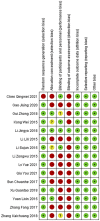Efficacy and safety of traditional Chinese medicine for intracranial hemorrhage by promoting blood circulation and removing blood stasis: A systematic review and meta-analysis of randomized controlled trials
- PMID: 36249750
- PMCID: PMC9553997
- DOI: 10.3389/fphar.2022.942657
Efficacy and safety of traditional Chinese medicine for intracranial hemorrhage by promoting blood circulation and removing blood stasis: A systematic review and meta-analysis of randomized controlled trials
Abstract
Background: Although blood-activating Chinese medicine (BACM) has been reported as adjuvant therapy for intracranial hemorrhage (ICH) in China, high-quality evidence is still lacking. Our study aimed to collect the latest high-quality randomized controlled trials (RCTs) and to evaluate the efficacy and safety of BACM for ICH. Methods: RCTs published between January 2015 and March 2022 were searched in databases, including China National Knowledge Infrastructure (CNKI), China Science and Technology Journal Database (VIP), Sino-Med, Wanfang, PubMed, Web of Science, Cochrane Library, and Embase without language restrictions. Eligible RCTs were included and both primary (clinical efficacy evidenced by decreased neurological deficit scores) and secondary outcomes (increased Barthel index, decreased NIHSS, hematoma volume, the volume of cerebral edema, the incidence of side effects, and mortality) were analyzed. The quality of included RCTs was assessed using the Cochrane risk of bias tool. In the meta-analysis, the pooled results were analyzed using Review Manager 5.3 and STATA14.0. Finally, The GRADEpro GDT software (Guideline Development Tool) was used to summarize the results. Sensitivity and subgroup analyses were conducted based on the follow-up time. Results: Fifteen RCTs, involving 1,579 participants, were included for analysis in our study. The pooled outcomes indicated that BACM combined with western medicine treatment (WMT) was superior to WMT alone for patients with ICH, demonstrated by the improvements in efficacy (RR = 1.22 (95% CI, [1.13 to 1.32], p < 0.001), neurological functions (MDNIHSS = -2.75, 95% CI [-3.74 to -1.76], p < 0.001), and activities of daily living (MDBarthel index = 5.95, 95% CI [3.92 to 7.98], p < 0.001), as well as decreased cerebral hematoma, cerebral edema (MD cerebral hematoma = -2.94, 95% CI [-3.50 to -2.37, p < 0.001 and MDcerebral edema = -2.66, 95% CI [-2.95 to -2.37], p < 0.001), side effects and mortality (RR = 0.84 (95% CI [0.60 to 1.19], p = 0.330 and RR = 0.51 (95% CI, [0.16 to 1.65], p = 0.260). In addition, Conioselinum anthriscoides "Chuanxiong" [Apiaceae], Camellia reticulata Lindl. [Theaceae], and Bupleurum sibiricum var. jeholense (Nakai) C.D.Chu [Apiaceae]) were the most frequently used herbs in the treatment of ICH. Recently, there was a trend toward the extensive use of another two herbs, including Rheum palmatum L. [Polygonaceae], Astragalus mongholicus Bunge [Fabaceae]) for ICH. Conclusion: BACM combined with WMT seems to be superior to WMT alone for patients with ICH. Further high-quality RCTs are warranted to confirm the efficacy and safety of BACM.
Keywords: blood stasis; intracranial hemorrhage; meta-analysis; systematic review; traditional Chinese medicine.
Copyright © 2022 Lin, Hou, Han, Zheng, Liang and Zhou.
Conflict of interest statement
The authors declare that the research was conducted in the absence of any commercial or financial relationships that could be construed as a potential conflict of interest.
Figures










Similar articles
-
Efficacy and safety of moxibustion treatment for upper extremity pain disorder and motor impairment in patients with stage I post-stroke shoulder-hand syndrome: a systematic review and meta-analysis of randomized controlled trials.Front Neurol. 2025 May 23;16:1530069. doi: 10.3389/fneur.2025.1530069. eCollection 2025. Front Neurol. 2025. PMID: 40488201 Free PMC article.
-
A Systematic Review and Meta-Analysis on the Efficacy of Puerarin Injection as Adjunctive Therapy for Unstable Angina Pectoris.Front Cardiovasc Med. 2022 Feb 24;9:763567. doi: 10.3389/fcvm.2022.763567. eCollection 2022. Front Cardiovasc Med. 2022. PMID: 35282378 Free PMC article.
-
Traditional chinese medicine injections with activating blood circulation, equivalent effect of anticoagulation or antiplatelet, for acute myocardial infarction: A systematic review and meta-analysis of randomized clinical trials.Complement Ther Med. 2024 Jun;82:103039. doi: 10.1016/j.ctim.2024.103039. Epub 2024 Apr 13. Complement Ther Med. 2024. PMID: 38616000
-
Clinical effectiveness of Tui Na for insomnia compared with estazolam: A systematic review and meta-analysis of randomized controlled trials.Complement Ther Med. 2019 Dec;47:102186. doi: 10.1016/j.ctim.2019.08.020. Epub 2019 Oct 22. Complement Ther Med. 2019. PMID: 31779989
-
Efficacy of Ligustrazine Injection as Adjunctive Therapy in Treating Acute Cerebral Infarction: A Systematic Review and Meta-Analysis.Front Pharmacol. 2021 Nov 22;12:761722. doi: 10.3389/fphar.2021.761722. eCollection 2021. Front Pharmacol. 2021. PMID: 34880757 Free PMC article. Review.
Cited by
-
Treatment of Intracerebral Hemorrhage with Traditional Chinese Medicine Monomer Wogonin by Modifying NLRP3 with METTL14 to Inhibit Neuronal Cell Pyroptosis.Appl Biochem Biotechnol. 2024 Sep;196(9):6174-6188. doi: 10.1007/s12010-023-04849-4. Epub 2024 Jan 15. Appl Biochem Biotechnol. 2024. PMID: 38224394
-
Neuroprotective effect of Naochuxue prescription on intracerebral hemorrhage: inhibition of autophagy downregulating high mobility group box-1.J Tradit Chin Med. 2024 Oct;44(5):944-953. doi: 10.19852/j.cnki.jtcm.20240515.003. J Tradit Chin Med. 2024. PMID: 39380225 Free PMC article.
-
Research progress on the application of Chinese herbal medicine in anal fistula surgery.Am J Transl Res. 2024 Aug 15;16(8):3519-3533. doi: 10.62347/DZHK5180. eCollection 2024. Am J Transl Res. 2024. PMID: 39262715 Free PMC article. Review.
-
Application of promoting blood circulation and resolving blood stasis in intracerebral hemorrhage: a traditional method gradually being reconsidered.J Tradit Chin Med. 2025 Apr;45(2):458-472. doi: 10.19852/j.cnki.jtcm.2025.02.017. J Tradit Chin Med. 2025. PMID: 40151133 Free PMC article. Review.
References
Publication types
LinkOut - more resources
Full Text Sources

